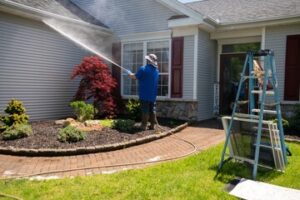A well-insulated roof is crucial to keeping out the summer heat and winter cold. This will help keep energy costs down and reduce strain on your home’s HVAC system.

Before beginning the installation process, make sure you have all the proper materials and understand how to properly do the work. Visit https://www.jmelitecontractors.com to explore the basics of roofing installation.
The roof over your head is more than just a shelter—it’s a pivotal design element, a bulwark against the elements, and an investment in your home’s longevity. With a seemingly endless array of roofing materials to choose from, making the best choice can be daunting. This comprehensive guide to roofing materials can help you understand your options and make an informed decision.
Asphalt shingles are a popular residential roofing material, favored for their cost-effectiveness and variety in color and style. They have a fiberglass or organic base covered with mineral granules, which add durability and resistance to weathering. When properly installed and maintained, these shingles can last 20 to 30 years or more.
Wood shingle roofs are often seen on historic and rustic homes. Made from split logs of cedar or redwood, they have a unique aesthetic that blends seamlessly into natural surroundings. However, these roofs aren’t as durable as other roofing materials and are prone to damage from fire and moisture.
Metal roofs have become increasingly popular for their durability and long-term performance. Available in a wide range of colors and styles, they provide an attractive aesthetic while providing excellent protection against the elements. These roofs are typically heavier than other roofing materials, and require regular maintenance to prevent corrosion.
Whether you have a flat or low-slope roof, the underlayment is an essential component of your roofing system. It serves as a waterproof barrier to keep water from seeping into your house during the construction process and helps protect against leaks in the future. It can also be used as a sealant to prevent water damage in the event of a roof leak.
The drip edge flashing is another critical part of your roof. It is placed along the edge of your roof to prevent moisture from seeping under the shingles and causing water damage. The most common drip edge flashing is pre-painted steel, but you can also opt for copper or galvalume if your roof is near saltwater.
Pipe vent flashing is necessary for any roof with plumbing penetrations. This allows for a balanced flow of air through your attic, reducing overheating and moisture buildup. It can also be installed to allow for gutters and other accessories to be hung from the fascia board.
Inspection
A roof inspection is the process of examining the existing roofing material to identify any issues. This includes inspecting the underlying deck for water damage or rot, as well as evaluating the flashing around vents, chimneys and valleys. It also involves ensuring that the new roofing is compliant with any local or homeowners association rules and restrictions. A professional contractor will handle the permit process and ensure that all requirements are met before starting work on a new roof.
The decking of the existing roof may need to be replaced in some cases. This is a common procedure in re-roofing projects where the original roof materials have suffered severe weather damage or have reached the end of their useful life. During this stage, the roofing contractors will also evaluate the condition of any underlying structures that are inaccessible from the roof surface, such as the plumbing and electrical systems.
Safety measures will be implemented to prevent falls during the roofing installation process. This may include the use of a ladder safety mobile application, infographics and tipsheets, toolbox talks, videos and safety leadership training.
Preparation
Roofers must be able to access the entire roof area, so they need to clear the surrounding areas. This includes removing outdoor furniture, grills, and lawn ornaments to avoid damage during the installation process. It also includes putting away items in attics, as vibrations from hammers and nail guns can dislodge them. Moreover, roofing contractors need access to power outlets, so they should clear any cords or other obstructions that could get in the way of their work.
It’s important for homeowners to prepare their homes before a roof replacement, as this will minimize disruption and save them money in the long run. For example, if you have children or pets, it’s a good idea to relocate them temporarily. This will prevent them from getting trampled or knocked over by the contractors and their equipment. Alternatively, you can hire a babysitter to look after them during the duration of the project.
You should also check the weather forecast for the week before the project begins. The Occupational Safety and Health Administration reports that overexposure to heat is the leading cause of construction-related deaths, so you should try to start work during the cooler months. This will help you finish the job before it’s too hot and allow your roofing crew to work comfortably.
Once the inspection is complete, the roofing contractor will prepare the roof for the installation process by removing any existing shingles and flashing. Then, the contractor will apply underlayment and felt paper to protect the deck from moisture. After that, they will install the new shingles. In some cases, they may also apply an ice and water barrier to protect the underlayment from snow and rain.
To ensure the quality of their work, professional roofers will inspect each shingle to see if it’s cracked or damaged. They will also make sure that all of the seams are properly sealed and that there are no holes or voids in the flashing or underlayment. In addition, they will use caulk to seal any gaps and cracks in the edges of the roof.
Installation
During roofing installation, the contractor will cover your garden or any other sensitive areas of your property with tarps to protect them from debris. They will also blow out your gutters and downspouts to clear them of any roof debris. They will then set up a dumpster on your property to hold the old materials they remove from your roof.
Then they will start the tear off process. This is when they will remove all the old shingles and other material from your roof. It may take a few hours for them to get everything off of your roof.
After the tear off is complete, the roofing contractors will install new underlayment and shingles. They will use a nail gun to speed up the installation process and gloves to protect their hands. They will also use a caulk gun to apply roofing caulk around the raw edges of your roof to make it watertight.








